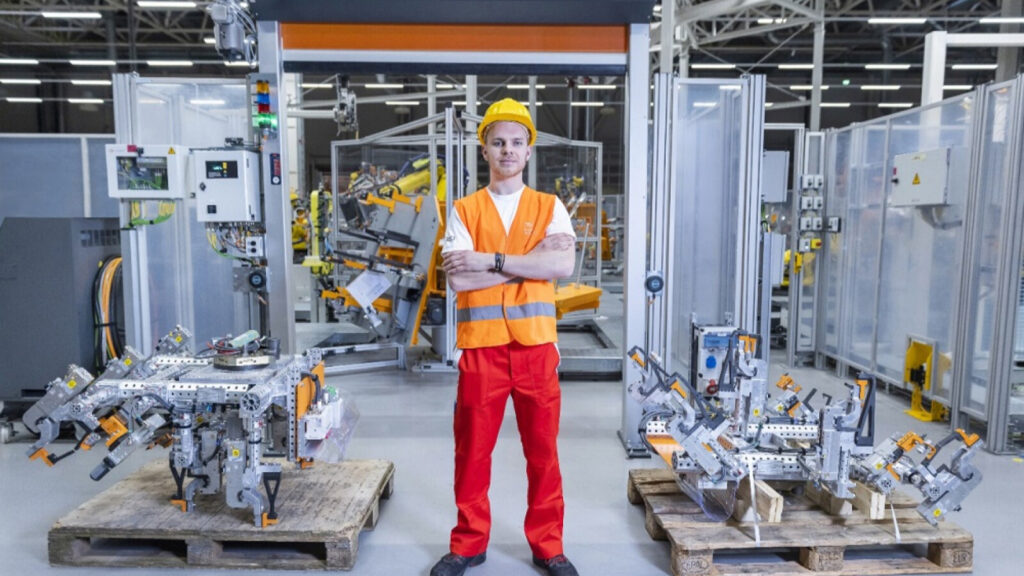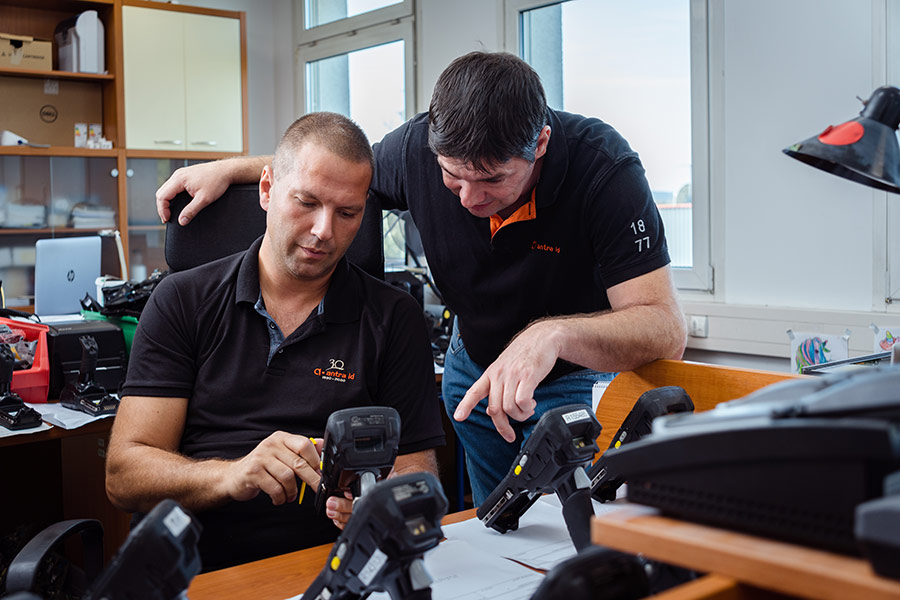Technologies such as systems that link enterprise information technology (IT) with production systems (OT) are fully embedded in manufacturing, creating a single platform for data collection, monitoring, and decision-making. Building and operating these systems is the job of suppliers such as Antra ID Ltd, which has decades of experience in the automotive industry. Whether an existing machine needs to be optimized or a new one developed, the goal is to guarantee reliability and high availability.
A new engine is born…
The engines produced at Audi Hungaria are assembled and tested on numerous production lines, at the end of which heavy-duty six-axis robots lift the engines onto the assembly line. One of the systems deployed by Antra ID reads the RFID tag from the pallet, which is matched to the engine’s factory number as reported by the robot. The product’s destination is read from the database, and the conveyor is instructed to deliver the motor to the specific pick-up point in the warehouse.
Audi Hungaria’s engine packing plant in Győr is also used to store the finished engines awaiting delivery. From the production line, the assembled and tested machines are transported to the packaging plant on conveyor belts that run several meters above the ground and are hidden from human view, with a few exceptions. Once they reach the collection point, the engines are placed on pallets – block stacking – and the pallet is given a bar-coded collection label. Therefore, the unique identification labels previously placed on the engines are read here; the data is transferred to SAP, which generates a collection code for the array, which is then printed out by the mobile label printer. Once glued and packaged, the engine block is immediately ready for delivery. Some engines are sent to Audi Hungaria’s vehicle factory, where they become the heart of the finished cars, while others find their destination elsewhere.

In a sea of codes
Every complex, intelligent system designed to be 100 percent efficient stands or falls on the tools in the field. In a car company’s logistics system, its workers’ handheld barcode readers and label printers are the front lines of its field devices. And ensuring their smooth operation has long been the responsibility of Antra ID Ltd. This goes well beyond the supply of marker tags. It also includes the maintenance of printers and the thousands of handheld scanners used and detecting and rectifying network faults.
The handheld scanners perform tens of millions of scans a year in the logistics process of the engines. Most of these are done with paper barcodes, while the barcodes identifying the engine blocks are applied to the surface by laser. The scanners must reliably detect all barcode types.
Replacing the handheld scanners one by one takes months of work for Antra’s technicians. Support for Windows-based software running on the old scanners has been discontinued, which would raise numerous security (and process safety) issues in the future, not to mention the fact that the supply of spare parts for the old scanners has also recently been discontinued.
Each handheld scanner has an internal Antra ID-generated serial number – which has nothing to do with the factory number – and as new scanners arrive, the same number of old ones are withdrawn from the logistics chain. The old and new scanners are assigned the same internal serial number so that no dust can get caught in the gears of the intralogistics process, while the old and new scanners are in similar service at the plant. So, the IT background is unchanged, but field hardware and software have been completely revamped – the new scanners now run Android-based software. Antra ID hands out all new scanners after testing, meaning they arrive in a packer ready for use immediately.
“They’re not even bothered until they’re working,” says technical support engineer György Podolák. – So old scanners will undoubtedly be brought to us for repair years from now, but that won’t be a problem, which is why we have virtually constant availability here.”
The philosophy: smaller warehouse, more products manufactured
Antra ID supports the automaker’s logistics process with handheld devices and more spectacular RFID gates. These devices, like the shoplifting gates we are all familiar with, have a detection range of seven to eight meters. Their purpose is to detect cargo being transported by tractors passing underneath. The more than 20 gates installed see the RFID tag and report its passage to the production control system in real-time.
“Most of the RFID gates have been placed between the warehouse and the production area, and the previous function of keeping track of the schedule has been extended,” adds György Podolák, “The appetite comes while eating, and once the gates are available, the operators can think about what else they can use them for. So, after the tractors, we also track the trailers and report the movements in the ERP system.”
The IT system also supports the delivery process, as the identification of the trucks makes it clear what products are to be placed on each car. The data tab also allows the truck to decide when it should be ready for loading at a set time. The vehicle is also automatically identified in the departure and arrival zones, thus completing the international logistics process of the car manufacturer.



